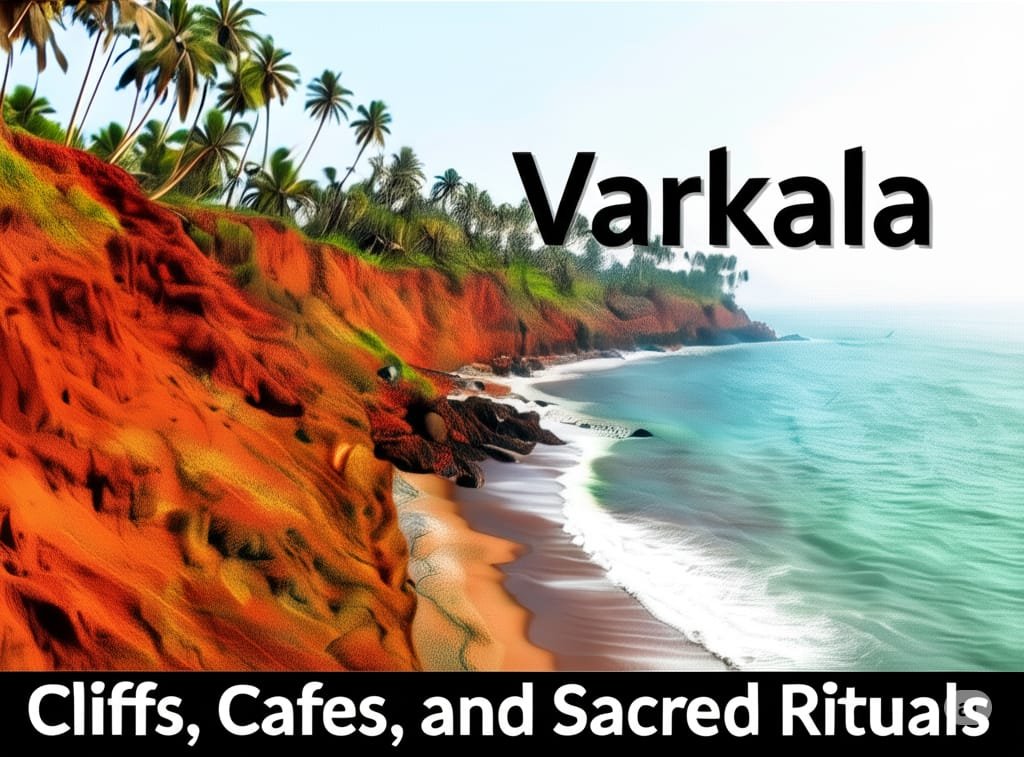Lashing rain in Trivandrum. Wet shoes. A hot cup of chai from a stall near the station. My Kerala story began here, not with sunshine, but with the raw, cleansing energy of the monsoon. My destination was Varkala, a town I knew only by its reputation for stunning cliff-side beaches. What I found was something far deeper: a place where hippie vibes and ancient spiritual rituals coexist beautifully on the edge of the Arabian Sea.
For those planning to explore this coastal gem, here’s a quick overview. The easiest way to reach Varkala is by a short train ride from Trivandrum. The town’s life revolves around its cliffs: the bustling South Cliff is famous for its café culture, while the North Cliff offers more peace. The spiritual heart is Papanasam Beach, where sacred pind daan rituals are performed daily, overlooked by the ancient Janardhana Swamy Temple. A day trip to the magnificent Jatayu Earth’s Center is highly recommended, but be sure to plan your travel time carefully.
A Rainy Start, A Soulful Journey
The train from Trivandrum chugged along, trading cityscapes for lush greenery. I arrived in Varkala and checked into Zostel, a backpacker’s hub perfectly perched with access to the dramatic Black Sand Beach and the main cliff path. The energy was immediately different from other parts of Kerala—more bohemian, more transient, a global village of travelers seeking sun and solace.
Life on the Cliff’s Edge: Sunsets and Solitude
After a long day of work, I took my first walk along the famed Varkala cliff. The sound of the waves crashing below was a balm to my tired soul. Most cafés on the vibrant South Cliff open after 10 AM, so my first evening was a quiet affair. I found a secluded spot on the dark sands of Black Sand Beach and watched the sunset. With very few tourists around, it was a moment of pure solitude—just me, the wind, and the sky on fire.
The next morning, guided by tips from fellow solo travelers at the hostel, I explored the quieter North Cliff. The early morning walk was longer, emptier, and profoundly more serene. This is the Varkala that truly calms you.
Papanasam Beach: Where Sins and Sorrows Meet the Sea
It was on my morning walk that I stumbled upon something deeply moving at Papanasam Beach. The name literally means ‘destruction of sins,’ as local belief holds that a dip in its waters cleanses one’s karma. That morning, the beach was not for swimmers; it was an open-air temple.
Under rows of umbrellas, priests in white were guiding families through pind daan ceremonies—the sacred Hindu last rites for ancestors. The air was thick with chants, incense, and a quiet, dignified grief. I was instantly transported back home, thinking of my own father performing these same rituals. Seeing it here, with the vast, impartial ocean as the witness, was incredibly powerful. It was a reminder of how faith provides a shared language for love and loss across cultures. A little further down the beach, I saw locals skillfully searching for crabs in the sand. Curious, I used Google Translate to ask what they were doing, sharing a small, funny, and deeply human moment of connection.
The Ancient Heart: Janardhana Swamy Temple
Overlooking Papanasam Beach is the Janardhana Swamy Temple, a spiritual anchor for the region for over 2,000 years. Dedicated to Lord Vishnu, its architecture is a beautiful example of Kerala’s ancient wooden craftsmanship. I learned that there’s a strict dress code: men must remove their upper garments before entering the inner sanctum, a sign of humility before the deity. Photography inside is prohibited, a rule that encourages you to be present and absorb the temple’s powerful, peaceful vibrations.
An Epic Excursion: Jatayu Earth’s Center
On one of my days, I planned a trip to Jatayu Earth’s Center, home to the world’s largest bird sculpture. Here, travel taught me a lesson in humility. My drone had crashed the day before, and I learned drones weren’t allowed there anyway. I also misjudged the distance—it’s a good 30 km from Varkala, not 20. I found myself in a last-minute rush to make it before the ticket counter closed for the sunset viewing. Thankfully, I made it just in time, and the staff were kind enough to store my camera bag in their free cloakroom. The view from the top, beside the colossal sculpture of the mythical eagle Jatayu, was absolutely worth the chaos.
A Conscious Traveler’s Guide to Varkala
- Where to Stay: For solo travelers and those on a budget, Zostel Varkala is a fantastic choice for its community vibe and perfect location.
- Getting Around: Scooty rentals are available right beside the hostel and are perfect for exploring the cliffs and nearby beaches. Autos are also readily available.
- Plan Your Jatayu Trip: Give yourself at least 1.5 hours to travel from Varkala to Jatayu. Book tickets online if possible, and be aware that the last entry is well before sunset.
- Respect the Rituals: If you visit Papanasam Beach in the morning, be a mindful observer. This is a place of deep personal significance for many families. Keep your distance and refrain from intrusive photography.
- Embrace Both Cliffs: Enjoy the bustling cafés and shops of the South Cliff in the evening, but don’t miss the serene, empty beauty of the North Cliff for a quiet morning walk.
A Final Reflection
I came to Varkala for the famous cliffs, but what I found was a beautiful paradox. It’s a place where you can find a lively café playing international music just a five-minute walk from a 2000-year-old temple where ancient rituals unfold every single day. Varkala isn’t just a destination; it’s a soulful blend of energies, a reminder that peace and vibrancy can, and do, beautifully coexist.

Leave a Reply